Downsizing[edit | edit source]
Pre-cutting[edit | edit source]
Pre-cutting is a necessary step prior to the grinding of large waste and hollow objects that have trouble of being picked up between the blades of the grinder (bottles, cans,...). Moreover, after the precutting, the density of the waste is well above the initial density, which improves the performance of the grinders. To minimize transportation costs, pre-cuttings must be done as early as possible, notably in case of long transports between the collection sites and the grinding site. It can be for example done on collection sites or transfer sites.
a. knives The most obtainable and least expensive cutting tools are obviously knives or other sharp objects such as cutters or machetes. Their employment however is exhausting and does not permit a high production rate. Moreover, when the thickness of the objects to be cut is large, the cutting becomes very difficult to achieve.
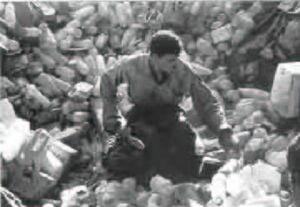
One solution is to partially melt the plastic by heating the blade. This is detrimental to the quality of the plastic.
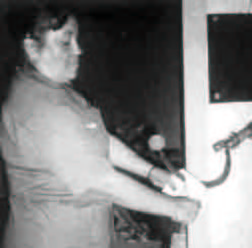
b. scissors Scissors are a cheap alternative to cutting. Rather than the simple pair of traditional scissors that limit the possibilities of fast cutting, we prefer a system mounted on a sturdy mount and fitted with a long enough arm lever. In Cairo, this type of tool can cut about 50 kg of plastic waste per hour.
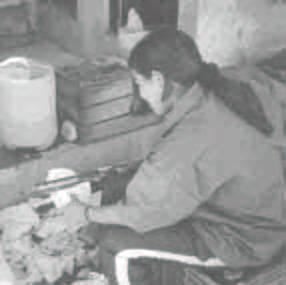
c. a jigsaw Jig saws or rotary saws are pre-cutting tools that are far more comfortable. Being widely used in the workshops specialised in wood, we can easily obtain them and at reasonable prices. d. the shredder When the flow of waste permits, we may foresee cutting using a shredder.[1] These machines are made of two-axis turning in opposite directions and are equipped with serrated knives. Once caught by the teeth, the products are shredded into strips.
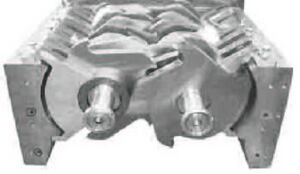
Shredders can cut large objects such as drums, plates or packaging. The size of the particles depends on the width of the knives. They are seldom less than ten millimeters. The rotation speed of the axes is relatively slow (between 50 and 80 revolutions per minute). The installed power to cut the plastic waste must be minimally 7 kW.[2] Throughput (kg/h) can be roughly calculated by multiplying power (kW) by 25:
- Throughput (kg/h) = ± 25_X_Power (kW)
The lifespan of the knives is about 1000 hours of work but they can be sharpened repeatedly.
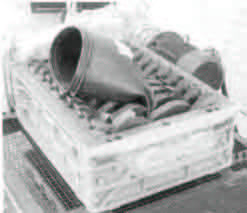
Some machines are equipped with 3 or 4 axes. Moreover, they can be fitted with a perforated grill. The size of the holes determines the maximum size of the particles. In this case, we must ensure that the width of the holes of the knives is greater than the size f the mouth (minimum 12 to 15 mm). The throughput should be reduced. Several passages of material are then recommended, with reduction of the size of the grill openings at each step.
| Charisteristics | Units | |
| Number of axes | (1) 2 (3 or 4) | |
| Width of the knives | mm | >10 |
| Rotation speed of the axes | rpm. | 50 to 80 |
| Power | kW | Min. 7 kW, max. >100 kW |
| Throughput | kg/h. | ±25_X_power |
| Grill opening | mm | >12 |
Table 4.2: General characteristics of shredders
Grinding[edit | edit source]
The step of grinding takes the plastic matter from a state of fragment to the state of "flake", that is to say, small pieces properly calibrated and aduquatly sized for introduction into processing machines (extruders, injection presses,...). The grinding of the plastics is done by shearing of which the principle is shown in the figure below.
In the plastic grinders, the shearing is produced by the cutting tools, the motor-driven knives. There are typically two kinds of grinders that differ by the orientation of the axis bearing the knives. a. Horizontal axis grinders These grinders are made of a rapidly rotating horizontal cylinder on which knives are mounted. The shearing is done between these movable knives and fixed knives attached to the frame of the grinder. A grid, placed under the knives, determines the size of the grinded fragments. The plastic fragments remain in the grinding zone until their size is smaller than the perforations of the grid.
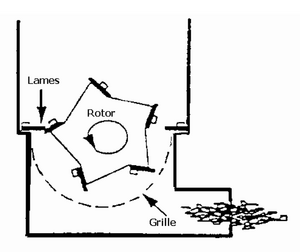
The rotor is driven by an electric motor via a transmission belt. The speed is usually between 250 and 600 rpm. To shield the engine from having to cope with too large shocks, a flywheel can be placed at the other end of the shaft. According to the machines, the number of mobile knives varies from 2 to 6 (typically 3 or 4). The knives are usually fixed in pairs. For a good performance of grinding, it is important to ensure that the space between the fixed and the mobile knives is as small as possible. In addition, the knives should be regularly sharpened or replaced when worn out. A good quality steel allows to extend their shelf life by around 1000 production hours. A 5 kW motor is the bare minimum for a good grinding of plastics, but an engine greater than 10 kW is recommended. We believe that the hourly throughput of these machines is 10 times the power of the engine:
- Throughput (kg/h) = ± 10_X_power (kW)
A regular feeding is necessary. It is unrecommended to keep the grinder running when empty. Considering the installed capacity, particular attention must be paid to the electric supply. An automatic startup may be necessary for large machines. In addition, a well visible emergency stop (with a large red button) is intended to stop the machine quickly in case of trouble.
| Characteristics | Units | Values |
| Number of knives | 2 to 6 | |
| Lifetime of the knives | hours | ± 1000 |
| Rotation speed of the axes | rpm. | 250-600 |
| Power | kW | >5 |
| Throughput | kg/h. | 10_X_power |
| Grill openings | mm | >4 mm |
Table 4.3: Characteristics of grinders with horizontal axis
The grinding area is protected by a metal shroud (see Figure 4.8). The superior part serves the feeding area. Its right angular geometry and flexible component will protect the operator of the return of particles projected by the grinder rotor. We must also ensure that the feed zone is sufficiently high so it does not touch the knives. A hinge should allow to rotate it for gaining access the rotor for cleaning or maintenance of the grinder. Everything must be mounted on a high enough frame to allow recovering the plastic flakes in the trays.
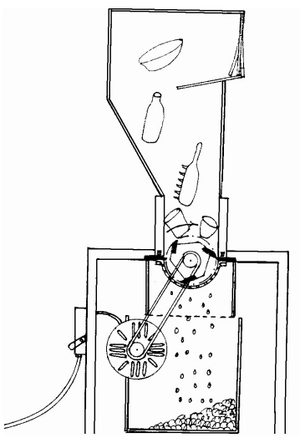
The grinding is a costly preparation step, notably in energy. It is therefore recommended to avoided the smaller cutting as much as possible by carefully choosing the size of the grid perforations. It is generally between 4 and 10 mm according to the size of the particles that can be accepted in the processing machines.
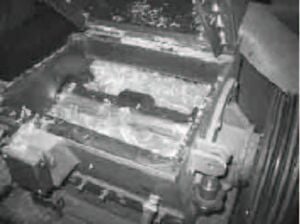
It is sometimes possible that grinding causes the heating of plastics to a degree large enough it to melt. This usually happens when the plastics introduced into the grinder are large, and the perforation of the grid is very small. The cutting time of the plastic in the grinding area is then too long. To remedy this problem, it is necessary to proceed in several steps with grids in which the perforations are successively smaller. An operator has a minimal mechanical experience; enough to control the proper functioning of the grinder. When production is great, a second person may assist him to manage the flow of materials.

Plastics must be grinded per campaign, that is to say, by type and color. After each campaign, a thorough cleaning of the machine must be conducted so as not to contaminate the next campaign. The retrieved plastic flakes are stored in bags unto which are labels are fixed describing the features of the product.
Note: Grinding is a noisy business! The grinder should be installed in a room which is as soundproofed as possible. The operator must protect himself against the noise (headphones, plugs,...). Moreover, if the center is located in urban areas we must respect a schedule acceptable to the surrounding population.
b. Vertical axis grinders The vertical axis grinders are much less efficient than orizontal axis grinders. Yet they are widely available in some countries because they are less expensive and easier to manufacture using traditional methods. Their design is actually simpler (see Figure 4.9). They consist of a cylindrical tub at the bottom of which knives revolve. The bottom of the tub consists of a perforated grid through which the plastic that is grinded enough can pass using gravity. The engine transmission is placed below the grid.
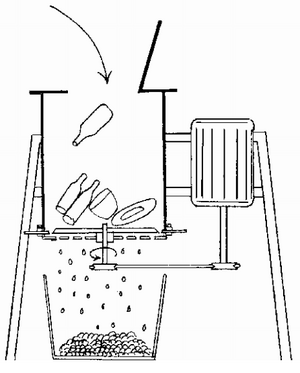
The plastic waste grinder mouth is at the top. In order to protect oneself of the upwards projected particles, the grinder is equipped with a hopper (see horizontal axis grinder) or with a valve system. Knives are used in pairs and are placed diametrically opposed. They must be sharpened regularly to ensure efficient grinding. At equal engine power, the capacity of vertical axis grinders is lower than that of horizontal axis grinders. Access to the grid is more difficult for horizontal axis grinders. It is necessary to disassemble the knives for the changing. Cleaning the grinder is also more difficult.
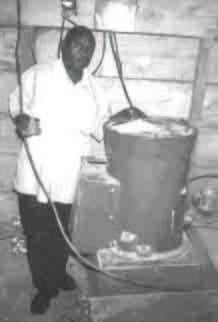
c. Crumber Grinded plastic films are too large and light so as to be introduced in extruders or injection presses. Their feeding is too difficult and the screws are difficult to use in these machines. An additional preparation step is necessary to convert them into more dense and manipulable flakes. This is done with a crumber. The design of this machine is very similar to the vertical axis grinders, except that it does not have a grill in its lower parts. Grinded plastic films remain for some time in the grinding zone. The extensive shearing that they undergo heats them up upto the temperature of softening. The volume of material then decreases rapidly (increased density). At this moment, cold water is introduced into the device, causing a sudden cooling of the material and making the material brittle. The plastic is then recovered in the form of small, irregularly shape granules, but of sufficient density so as to allow later introduction into the processing machines. The required driving force to heat up the plastic is high (minimally 15 kW, triphase). Furthermore, it must undergo major power changes. About five minutes are necessary to soften up the plastic films. Production capacity varies between 40 and 70 kg per hour. The obtained granules can be screened on a grid in order to be calibrated. The too fine particles are reintroduced into the crumber. The introduction of water produces a lot of steam that must be removed using a ventilation system. Changes in temperature and the presence of steam promotes corrosion. An anti-rust treatment must be applied regularly to all of vital parts of the device. Crumbers are very dangerous and relatively expensive machines requiring a cost-benefit analysis before executing the purchase (sufficient amount of plastic films, markets,...). Local manufacturing machines are common in some countries (India, Egypt, Turkey, Mexico,...).
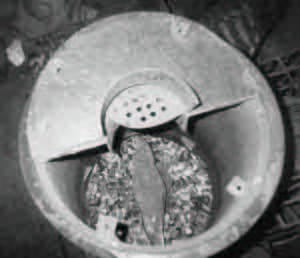
| Tool | Power | Throughput | Advantages | Disadvantages |
| Knives | 15 to 25 kg per hour and per person | Possibility of "upstream" pre-cutting. Cheap material. | Weak cutting capacity. Exhausting labor. Limited to thin waste. | |
| Fixed scissors | 50 kg per hour per person | Possibility of "upstream" pre-cutting. Lever allows the cutting of thicker sections. Robust hardware. | Limited cutting capacity. Exhaustive labor. | |
| Jigsaws | <5 kW | 40 to 80 kg/h | Motorised system, much more sustainable work. Improved production. | Equipment not designed for cutting plastic (sometimes inappropriate and not very robust). |
| Shredder | >7 kW | > 100 kg/h | Robust system with a high production capacity. Cutting into small fragments, even for rounded objects. | No possibility of "upstream" pre-cutting. Often large investments costs. |
| Horizontal axis grinder | > 5 kW | > 50 kg/h | Robust material, high capacity. Rapid cleaning and maintenance. | Expensive equipment, often imported at great costs. |
| Vertical axis grinder | > 5 kW | > 30 kg/h | Cheaper and easier to make than horizontal axis grinders. | Not very robust. More difficult grid cleaning and changing. Lower capacity. |
| Crumber | >10 kW | 40-70 kg/h | Device specificly used for plastic films. | Costly device that consumes a lot of electricity. |
Table 4.4: Summary of cutting and grinding techniques
Purchasing a grinder: The purchase of a grinder is an important and sensitive issue for which we must take the following considerations into account:
- The first important factor to determine is the required power. As stated previously, it is determined from the throughput of the matter to grind with a minimum of 5 kilowatts. It is always advisable to oversize the grinder, and this for two reasons: to limit heating and to provide the possibility of increasing the production. Grinding is a step prior to the shaping, the grinder should thus be able to comply with the transformation tools.
- The maximum size of the plastic waste entering the grinder is a second important type of data. It determines the minimum size of the feeding zone. If no such device allows the introduction of such pieces of plastic, a pre-cutting step is essential.
- What are the options regarding electricity? This data will be crucial for suppliers or manufacturers of the equipment: frequency, voltage, number of phases...
- The mode can also be important. For use without stops (regular flow of the same kind of plastic), a powerful grinder is necessary to avoid overheating. For use by campaign (small flows of different kinds of plastic, with cleaning of the grinder in between), a smaller grinder may be sufficient. It will cool during the the cleaning.
Other questions can also be asked:
- What facilities are the cleaning features and the features regarding the grill change ?
- What is the frequency of maintenance ? The lifetime of the knives?
- Does the device comply with the basic safety regulation ?
- What are the conditions for payment and the transportation of the equipment? What warranty is offered on the purchase of the unit? Is there an after-sales service in the country?
- Is the device anchored or or mounted on wheels ?
There are 3 potential markets for the purchase of a grinder:
- Most industrial machines are manufactured in Europe and Northern America. A second-hand market for the machinery is also well established in these countries, but their cost is often high. Most suppliers have well designed websites. For each device, the information is generally included: machine type, brand, power rating, type of possible power supply, width and diameter of the rotor, the number of fixed and mobile knives, the size of the feeding zone, total size of the machine, weight,... These technical sheets are often accompanied by photographs allowing to see the machine. The price is indicated or e-mailed on request. Before considering the purchase, always inquire about conditions and transportation costs (insurance, import fees, taxes) as well as the warranty. Indeed, a number of additional costs may increase the price of the machine by 50-60%!
- A cheaper alternative than the one described above is the Indian or Chinese market. The recycling of plastic waste is indeed well established in these countries to the point that there are workshops that manufacture specific machines for this activity. The grinders are generally simplified duplicates of imported machinery. The price difference is due to lower manufacturing costs, a less extensive finishing and the dismissal of any safety or noise reduction systems. Sacrifices have also been made regarding robustness regarding the after-sale service. Countries such as Turkey, Mexico and Egypt also have such markets.
- The third possibility is to build one's grinder at a local mechanical workshop. In this case, it better to go to workshops with experience in this field and to follow the assembly to ensure the robustness of the machine. The easiest grinder to make is the vertical axis grinder. Other machines, inspired by traditional cassava grinders can generate small productions, provided that all parts are oversized: the grinding of plastics is indeed more difficult than the grinding of cassava! Knives must be securely mounted unto the rotor.
The advantages of locally manufactured grinders are cost, potential adaptation to specific applications and no problems regarding import. These machines are less efficient (significantly higher electricity costs), less robust (frequent maintenance, low lifetime) and less safe (sometimes dangerous).
When purchasing the grinder, it is better to directly get 1 or 2 knife sets, replacement belts, a set of different grid openings,...